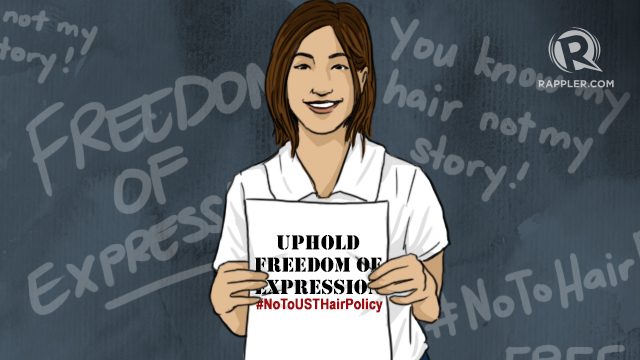SUMMARY
This is AI generated summarization, which may have errors. For context, always refer to the full article.

MANILA, Philippines – When the University of Santo Tomas’ Faculty of Arts and Letters revived on September 1 its haircut policy – males cannot wear long hair or any accessories – the United Journalists of the Philippines-UST released a photo album on Facebook, showing students with different hairstyles.
Some believed one’s hairstyle was a means for self-expression; others argued that students can choose to follow the rule or simply leave the school. A smaller group was said that UST’s administration should be focusing on much bigger things. (READ: UST hair policy for students: This is not about vanity)
Hairstyle as self-expression
Readers against UST’s policy believe that a person’s hairstyle is his own business and that whatever a person chooses to do with his hair is his way of expressing himself.
Ted Tuvera commented, “The university is an avenue for one to determine his/her identity and, apparently, through fashion statements like hair styles.”
For Jyl Carson, having an alternative hairstyle “is not about being disobedient – it’s just being you.” She also argues against what she sees as the policy’s promotion of “prejudice against people who choose to express themselves through their physical appearance. It does not promote acceptance and respect.”
Follow the rules or leave
Some argued that enrolling in a school means following the rules that the institution sets. Jade Quiamco commented on the album: “It is just that, the admin wants a more decent look for their students…. If you don’t like the rules, leave UST.”
The comment sparked a debate.
Christian Burgos agreed with Quiamco, saying: “It’s the school policy. Do you want to enroll in a school that let’s [sic] their student [sic] disobey their rules and regulations?”
Bastin Adrias disagreed with Quiamco: “Ano pa yung point ng pagtawag sa AB na Liberal Arts College kung ikakahon lang din pala ang mga estudyante sa mga norms na gusto ipataw ng UST sa kanila? (Why call AB Liberal Arts College if they are just going to box their students in whatever norms UST wants to impose?)”
For other readers, the rules UST set is part of the training students receive in preparation for professional life. “It’s part of discipline. It’s part of getting you ready for the corporate world,” wrote Gayle Oyardo.
Rules, they said, are part of teaching students to become law-abiding citizen. It is “so much more than just the hair,” wrote Jan Ray Perez. He also said, “I think you either live with the re-implemented rules for the next couple of years and do whatever you want after graduating or just find another university.”
Bigger fish to fry
While the two sides argued over whether the policy promoted conformity, others questioned the point in the administration’s decision to pursue this matter over other, supposedly more important, issues.
Alex Arellano, for example, called out UST’s administration, saying, “Don’t you have more important things to worry about than hair cuts and hair color?”
Serene Christyear de Vera cites the issues of “the missing 50K funds and the long delay of delivery of the type b uniform” as issues in need of greater attention.
What do you think about the policy? Let us know in the comments section below. – Rappler.com
Bea Orante is a Rappler intern.
Add a comment
How does this make you feel?
There are no comments yet. Add your comment to start the conversation.